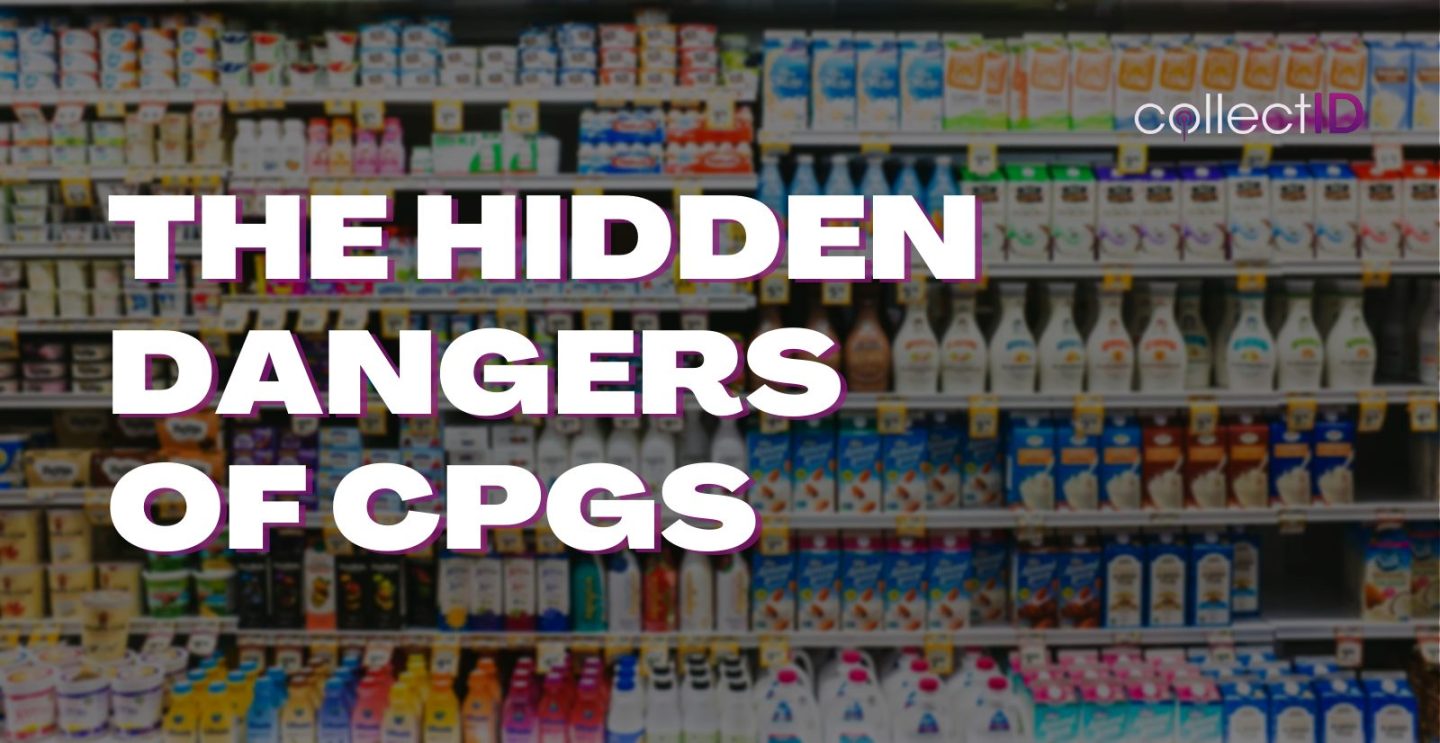So what are CPGs? A consumer packaged good (CPG) is an item frequently used, consumed, and replaced by everyday consumers. CPGs are typically produced by large consumer goods companies and sold through a variety of retail channels, including brick-and-mortar stores and online retailers.

The CPG market is constantly changing with emerging trends, and many CPG companies will do nearly anything to keep up with trends and competition to maintain a profit – even if it means putting customers at risk. As consumers, we must trust the brands we buy from and have confidence the products we use are safe, especially the ones we use on a daily basis.
While awareness and regulation are increasing regarding product safety, new technologies can be used to help brands protect their image and ensure customer safety.
What are CPGs and what products are considered CPG?
Consumer Packaged Goods is a category of products that includes any tangible items that are consumed by individuals on a daily or regular basis such as food and beverages, personal care and beauty products, cleaning supplies, and household items.
Specific examples of CPG products include breakfast cereals, coffee, soft drinks, snacks, frozen meals, bread, bottled water, beer, shampoo, baby food, toothpaste, soap, laundry detergent, paper towels, toilet paper, body wash, and much more. These products are typically sold in supermarkets, grocery stores, drug stores, and other retail outlets, and are often targeted at a wide consumer base. To get a better understanding of CPGs, here are a few common characteristics of these types of products:
- Short shelf life: As frequently purchased items, CPGs sell quickly from the shelves. Unlike durable goods, which may last for several years, CPGs are items that are consumed and replaced within a short period of time. Because of this, supply chains for CPGs need to be highly efficient in order to meet the high consumer demand for these products.
- Competition: One of the key characteristics of CPGs is that they are highly competitive items. Companies that produce these products often have to fight for the limited shelf space in retail stores and compete with other recognizable brands like Coca-Cola. To remain competitive, CPG companies often invest heavily in marketing and advertising campaigns.
- Low cost: Due to the high competition between CPG brands, these products are sold at a relatively low price. In order to keep prices low and remain competitive, companies must carefully manage their supply chains and ensure that they are able to purchase raw materials at reasonable prices.
- Low switching costs: Most CPG products are easy to replicate, making allowing customers to cheaply switch between brands selling similar products.
- Low customer loyalty: Due to high competition and low switching costs, customer loyalty to a particular CPG brand is also low.
- Regulation: A variety of laws and regulations govern the production and sale of these products, particularly when it comes to items like over-the-counter drugs and dairy products.
What are the dangers of CPGs?
Despite the regulations that come with producing CPGs, the popularity of these products and the competitive nature of the industry can lead to a dangerous counterfeit market.
Food counterfeiting and manipulation are growing concerns among CPGs, with countless incidents of fake and adulterated food products being sold to consumers. Technology-based solutions are in development to combat this issue, such as mobile apps, DNA analysis, and high-tech packaging, to help consumers protect themselves from these dangerous products.
Though the fight against food counterfeiting and manipulation continues, these technological advancements allow consumers and regulators to better identify and avoid dangerous products, ultimately contributing to a safer and more authentic food supply. You can read the full article here.
Are big brands safer from fake products?
Several big food and supermarket brands have been caught faking ingredients or labeling in order to increase profits.
- Nestle: In 2013, food giant Nestle was found to have sold horse meat labeled as beef in their products across Europe.
- Tesco: Another major case involved a popular British supermarket chain, Tesco, which in 2014 sold beef burgers containing horse meat, leading to a major product recall.

- Blue Bell Creameries: In 2016, Blue Bell Creameries, a Texas-based ice cream company, was forced to recall all of its products after they were found to be contaminated with Listeria.
- Walmart & Trader Joe’s: Similarly, in 2018, pre-packaged vegetable products sold in several major supermarkets in the United States, including Walmart and Trader Joe’s, were recalled due to the presence of salmonella.
- Azure Standard: In 2019, a major scandal involved the sale of fake organic grains by Iowa-based company, Azure Standard, leading to widespread recalls and distrust among consumers.
These cases demonstrate the importance of ensuring the authenticity and safety of food products.
How common is it to find fake products in supermarkets?
The frequency of finding fake products in supermarkets varies depending on location and the specific industry. However, cases of food counterfeiting and manipulation have become increasingly prevalent and alarming in recent years.
In many countries, there have been numerous incidents of fake and adulterated food products being sold to unsuspecting consumers, often with highly toxic and carcinogenic consequences. The global nature of the food supply chain, along with a large number of products available in supermarkets, makes it difficult to monitor and prevent all incidents of food fraud. That’s why it is essential for consumers to remain vigilant and educate themselves on how to identify potentially dangerous products.
What is the difference between CPG and FMCG?
Consumer Packaged Goods and Fast Moving Consumer Goods (FMCG) are usually often used interchangeably, as FMCG is a subset of CPG. FMCG refers to products that have a high turnover rate and are sold even more quickly than CPGs.

What is the difference between CPG and Durable goods?
CPGs and durable goods are two different categories of products that differ in terms of their durability and consumer use.
CPG products are intended for personal consumption and are typically used up or replaced within a relatively short period of time, such as food and beverages, personal care products, and household items. These products are usually sold at relatively low prices and have a shorter lifespan than durable goods.
Durable goods, also known as slow-moving consumer goods, are products that are designed to last for an extended period of time and are typically more expensive than CPG products. Examples of durable goods include cars, appliances, washing machines, furniture, and electronics. Durable goods are typically considered to be long-term investments, and as such, consumers generally expect them to have a longer lifespan.
What are the most important trends in the CPG industry today?
The CPG industry is constantly evolving and the latest trends effect the way products are marketed, produced, and distributed. Some of the most important trends in the industry today include:
- E-commerce: The growth of e-commerce has impacted the CPG industry in significant ways, with many consumers opting to purchase products online, rather than in physical stores. Companies are now investing more in e-commerce strategies to meet consumers’ needs.
- Sustainability: Consumers are increasingly demanding sustainable and eco-friendly products. This trend is driving companies to adopt more environmentally friendly practices, such as using renewable energy and reducing packaging waste.
- Personalization: Consumers are looking for products that are tailored to their individual needs and preferences. Companies are using data to gain insights into consumers’ buying habits and preferences, allowing them to develop and market more personalized products.
- Health and wellness: With an increasing focus on health and wellness, consumers are looking for products that offer nutritional benefits, natural ingredients, and functional health benefits.
- Transparency: Consumers are seeking more transparency in the products they purchase, including ingredient lists and sourcing information. Companies are responding by providing more detailed product information and incorporating labels like “clean” or “natural” to appeal to consumers.
These are just a few of the most important trends in the CPG industry today. Companies that stay on top of these trends and adapt to changing consumer demands are more likely to succeed in this competitive market.
Why is the demand for transparency so important?

The demand for transparency allows consumers to make informed decisions about the products they purchase and use. Transparency enables consumers to have access to information about the ingredients, sourcing, manufacturing, and safety of products, giving them the ability to make choices based on their own values and priorities.
In recent years, there has been a growing awareness and concern around issues such as product safety, environmental impact, and social responsibility. Consumers are increasingly looking for products that align with their values and are produced in a way that they deem ethical and sustainable. To meet this demand, companies are realizing the importance of being transparent about their practices and policies.
Transparency also helps to build trust between companies and consumers. When companies are open and honest about their processes and policies, it can enhance their reputation and credibility, and increase customer loyalty. On the other hand, a lack of transparency can lead to mistrust and a loss of consumer confidence.
Overall, the demand for transparency is an important factor driving the shift towards a more responsible and sustainable approach to business. It enables consumers to make choices that align with their values, encourages companies to be more accountable for their practices, and helps to build trust and credibility in the marketplace.

Can I protect myself with collectID technology?
With collectID technology, brands and consumers can both benefit from technology like collectID’s. Brands can integrate secure collectID NFC tags into their product. This chip contains unique and encrypted information about the product, such as its origin, ingredients, and manufacturing process. By scanning the chip and registering their product through the collectID app, consumers can instantly verify the authenticity and safety of the product, as well as access additional information about the product that the manufacturer provides.
Our technology offers an extra layer of protection against counterfeiting and manipulation, making it easier for consumers to make informed purchasing decisions and protect themselves from dangerous and fraudulent products. Contact us if you are interested in learning more!















